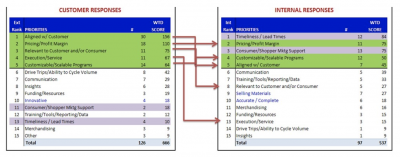
Your customers’ requirements will evolve from the Voice of the Customer (VOC). The process of that translation is the subject of this article. We will define how to derive your customer requirements, why you would want to do that, and some actions that you should take to achieve the definition of your customers’ requirements.
Overview: What are customer requirements?
The development of customer requirements begins with the gathering of the Voice of the Customer (VOC). You can define a customer as the direct receiver of your process’s output, whether it be a tangible product or a service. You can have both internal and external customers. In all cases, your customers will have wants, needs, and requirements.
Your customer will often say to you, “I want this.” You may reply, “What do you need this to do?” In many cases, your customer’s wants will not achieve what they need to be done. Your job is to understand the underlying needs of your customer. These are generally expressed in terms of some qualitative statement such as, “I need my delivery to be faster.” But that does not provide a very clear indication of what their need really means. That is why we will need to drive to a specific customer requirement. Many organizations refer to these as critical customer requirements, or CCRs.
Good customer requirements are:
- Specific, measurable, and define how you will measure them
- Related directly to some characteristic or attribute of your product or service
- Not biased to a particular solution
- Complete, clear, and lack ambiguity
- What the requirement is, not how it will be met
Here is an example of the process.

Now, you have a specific, definable, and measurable characteristic of your process.
A very useful model for classifying customer requirements is the Kano analysis, named after Dr. Noritaki Kano, who is an educator, lecturer, writer, and consultant as well as a winner of the Deming Prize.
The Kano model addresses the three types of requirements:
- Dissatisfiers (Must Haves): These are the basic requirements expected by your customer. Your hotel room “must have” a bed as a minimum requirement.
- Satisfiers (Performance): More is better, at least up to a point. Your hotel bed has a nice comforter and is soft and comfortable.
- Delighters (WOW): These generate real excitement and are usually not even in the mind of your customer. Your hotel bed is a Sleep Number bed with a built-in massager and speakers. The problem is that most Delighters are expensive and can soon develop into basic requirements and expectations. You now want every hotel you stay at to have a Sleep Number bed or else you will be dissatisfied.
3 benefits of knowing your customer requirements
Your primary purpose of being in business is to satisfy your customers. By doing a better job than your competition, you will improve your chances of being successful. Here are some of the benefits of knowing your customers’ requirements.
Focus on the right things
If your customer has specific requirements about on-time delivery, you may not want to divert resources away from delivery issues to new product development.
Provide measurement
Your customer requirements should be defined in quantitative terms as best as possible. This will give you a chance to collect data to better understand how well you are satisfying your customers’ requirements.
Reduce miscommunication
If you and your customer have agreed upon definitions of their requirements, then the ambiguity is eliminated, and everyone is measuring the same thing the same way.
Why are customer requirements important to understand?
The better you understand your customer requirements, the better your organization will be able to satisfy these requirements.
Your customer pays the bills
If you don’t satisfy your customers’ requirements, your competition will. Since your customer pays the bills, you want to make sure they’re getting what they want/need.
Priorities
Not all customer requirements are equal. Not only do you need to have a common understanding and definition of your customer requirements, you also want to know the relative priority of each so you can work on the things that are most important to your customer.
Link to key process variables
Once you know the details of your customer requirements, you can link them to the specific processes in your organization that will impact whether you can satisfy them or not.
An industry example of attending to customer requirements
After hearing a number of complaints from major customers regarding customer marketing and promotional activities, the CEO chartered a team to address the issue. One of the first activities the team did was to execute a widespread collection of the VOC. Not only did they collect VOC from the external customers, they also collected information from internal employees about what they thought the customer requirements were.
The team concluded that the internal organization was totally misaligned with what the customer requirements were. Below is a summary of the misalignment.
Note that the customer’s No. 1 requirement was alignment with their promotion schedule, whereas the internal organization ranked it as number five. Likewise, the internal organization ranked timeliness/lead times as No. 1 while the customer ranked it No. 13 on their prioritized list of requirements.

The CEO indicated that he wanted the team to pay immediate attention to this misalignment. Marketing leadership met with the customers, and a new process was developed to allow the company to do a better job satisfying the customers’ requirements.
3 best practices when thinking about customer requirements
Based on the experience of a number of organizations, here are a few suggestions on how you can do a better job of understanding and meeting your customers’ requirements.
1. Don’t assume you know
Don’t substitute your opinion of what your customers’ requirements are. Get them directly from your customer.
2. Qualitative to quantitative
Be sure you drive the subjective and ambiguous VOC that you will get from your customer to an agreed-upon, well-defined, and measurable quantitative value.
3. Align with your customer requirements
Knowing your customer requirements is not enough. You need to link the desired outcomes with your processes that have the most influence on your ability to meet their requirements.
Frequently Asked Questions (FAQ) about customer requirements
What are some examples of customer requirements?
These would include such things as quality, price, functionality, performance, convenience, safety, compatibility, and available options.
What is the relationship between the voice of the customer and customer requirements?
A customer requirement is the translation of the more qualitative Voice of the Customer into a definable, measurable and quantitative value.
Can the Kano Model be used to help define customer requirements?
Yes, the Kano Model is used to categorize customer requirements into three groups. The “must haves” are required and must be there as a minimum. The “satisfiers” are the requirements that are performance-based. The “delighters” are “Wow” requirements that the customer didn’t even know existed but will make them excited if they are met.
The takeaways about customer requirements
While it might be a challenge, it’s imperative that you fully understand your customers’ requirements for all aspects of your business relationship. They need to be unambiguous, well-defined, and measurable so there is no misunderstanding as to what they require and what you are providing.
Starting with the Voice of the Customer and evolving to the specific requirement will allow you to focus on what is most important to your customer — and know whether you are meeting their requirements or not.